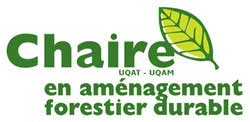Maxence Soubeyrand, Philippe Marchand, Louis Duchesne, Yves Bergeron, Fabio Gennaretti. Interactions between climate, soil and competition drive tree growth in Quebec forests 2024. For. Ecol. Manage. 121731
DOI : 10.1016/j.foreco.2024.121731
Climate, soil, and competition factors jointly drive tree growth variability at local and regional scale. However, the comprehensive interaction of these factors and their combined effects on tree responses within their environment remains poorly explored in current research. Using a detailed forest inventory dataset in Québec, we examined tree growth of balsam fir (Abies balsamea Mill), black spruce (Picea mariana Mill), red maple (Acer rubrum L.), sugar maple (Acer saccharum Marshall), white birch (Betula papyrifera Marshall), and yellow birch (Betula alleghaniensis Britton), as a function of competition for light and space with neighboring trees, climate and soil-related variables. Interactions between all these variables were considered in a Bayesian model predicting tree growth. The amount of light received by trees was the main variables explaining tree growth except for coniferous tree species which was influenced mostly by climate variables. Among the studied species, only red maple and white birch exhibited increased growth under warmer conditions. Intraspecific competition had strong species-specific impacts, varying from negative effects for balsam fir, to positive for red maple and yellow birch. Interactions between climate, soil, and competition played a crucial role in shaping growth patterns, especially for sugar maple, and black spruce that strongly responded to a combination of climate and competition factors. In general, tree growth also increased with the soil cation-exchange capacity (CEC), especially when higher CEC is coupled with higher temperatures and precipitation, except for black spruce. While anticipated climate conditions in Quebec, even under the most optimistic scenarios, will have a strong negative impact on the tree growth of most tree species, management can mitigate this impact by promoting tree diversity with more complex stand structures.
Maxence Soubeyrand, Nils Ambec, Marianne Vogel. Feux de forêt: un nouveau cycle pour la biodiversité. 2024. Le Couvert Boréal p. 11
Marion Noualhaguet, Timothy Work, Maxence Soubeyrand, Nicole J. Fenton. Twenty-year recovery of managed stand, in structure and composition, in boreal mixedwood stands of northwestern Quebec 2023. Can. J. For. Res. 478
DOI : 10.1139/cjfr-2022-0309
The natural disturbance-based management (NDBM) aims to maintain specific structural and compositional attributes of natural forests in managed stands. Operationally, NDBM relies on diversifying and adapting silvicultural practices, including partial harvesting (PC), to expand the range of options beyond that of simply clearcuts (CC).
Nils Ambec, Marianne Vogel, Maxence Soubeyrand. La vannerie sauvage. 2023. Le Couvert Boréal p.10
Nils Ambec, Marianne Vogel, Maxence Soubeyrand. Ces poissons mal aimés. 2023. Le Couvert Boréal p.24
Marion Noualhaguet, Timothy Work, Maxence Soubeyrand, Nicole J. Fenton. Bryophyte community responses 20 years after forest management in boreal mixedwood forest. 2023. For. Ecol. Manage.
DOI : 10.2139/ssrn.4292682
Sustainable forest management relies on a diversity of harvesting practices to conserve the variety of stand structures and compositions found in natural forests. Extensive use of clearcuts can homogenize stand structure by removing all the canopy, damage forest soils and destroy older downed woody debris already present within stands. In contrast partial cuts maintain some standing overstory and conserve certain biological legacies like large live trees as well as standing and downed dead wood, and thus should better conserve biodiversity. However, given the large number of species potentially affected by harvest operations, balancing harvesting intensity and conservation of biodiversity requires a clear understanding of habitat requirements of resident organisms and species conservation post-harvest. We examined the impacts of increasing intensities of stem removal (33%, 40%, 66% and 100%) 20 years after harvest on bryophyte communities in three stand types common in the succession sequences of Eastern boreal mixedwood forests that were dominated by trembling aspen, mixedwood and conifers. While many generalist and common forest species were shared among all harvesting levels and forest types, more specialized species like liverworts differed strongly between uncut and clearcut stands. However, liverworts and other specialists differed less between uncut and partial cut stands. Bryophyte species in hardwood dominated stands tolerated more fluctuations in environmental conditions than species in mixed stands. We were unable to find habitat specialists typically associated with coniferous stands and may be related to prior outbreaks of spruce budworm that occurred 30 years ago. Our results highlight how harvest intensity and forest stand type interact to affect bryophytes and how intact stands may be required to conserve many species that are sensitive to any degree of harvesting.
Nils Ambec, Marianne Vogel, Maxence Soubeyrand. Le temps des pêches commerciales abitibienne. 2023. Le Couvert Boréal p.25
Maxence Soubeyrand, Fabio Gennaretti, Olivier Blarquez, Yves Bergeron, Anthony R Taylor, Loïc D'Orangeville, Philippe Marchand. Competitive interactions under current climate allow temperate tree species to grow and survive in boreal mixedwood forest. 2023. Ecography e06525
DOI : 10.1111/ecog.06525
With climate change, climatic optima are shifting poleward more rapidly than tree migration processes, resulting in a mismatch between species distributions and bioclimatic envelopes. Temperate hardwood tree species may take advantage of the release of climate constraints and forest management to migrate into the boreal forest. Here, we use the SORTIE-ND forest simulation model to determine the potential for the persistence of three temperate species (sugar maple, red maple and yellow birch) when introduced at seedling stage in typical balsam fir–paper birch (BF–PB) bioclimatic domain stands of eastern Canada, quantifying the consequences on the native species composition. SORTIE-ND is a spatially explicit, individual-based forest stand model that simulates tree growth, regeneration and mortality. We performed a novel parameterization of the SORTIE-ND tree growth equation allowing for the inclusion of climate modifiers on tree growth. After validating our model with data from permanent forest inventory plots, we modeled the dynamics of unharvested stands at different successional stages, as well as post-harvest stands, after the addition of sugar maple, red maple and yellow birch seedlings at different densities. Our results show that current BF–PB domain climate conditions do not limit growth and survival of temperate species in boreal stands. Of the temperate species introduced, sugar maple had the lowest ability to grow and survive by the end of the simulation. Species assemblages of host stands were impacted by the presence of temperate species when the addition of seedlings was above 5000 temperate seedlings per hectare at the beginning of the simulation. For stands that were recently clear cut, temperate seedlings were unable to grow due to intense competition from aspen regeneration. Our results suggest that both current climate and competitive interactions between temperate species and boreal species should not impede the ability of temperate species to grow and survive in the BF–PB domain.
Maxence Soubeyrand, Marine Dupassieux, Philippe Marchand. Des feuillus tempérés dans les forêts Abitibiennes? 2022. Le Couvert Boréal p.16
Nils Ambec, Marianne Vogel, Maxence Soubeyrand. Pour une pratique éthique de la pêche. 2022. Le Couvert Boréal p.15
voir la liste complète
Maxence Soubeyrand L'abondance des populations nordiques de 14 espèces tempérées est principalement limitée par des conditions climatiques froides. 4e rencontre annuelle du Laboratoire International de Recherche sur les Forêts Froides. Ifrane, Maroc (2024-10-23)
Maxence Soubeyrand, Fabio Gennaretti, Pierre Grondin, Yves Bergeron, Philippe Marchand. Effet du climat et de la compétition sur la migration future vers le nord d'espèces de feuillus tempérés dans la forêt boréale mixte 17e colloque annuel du CEF, Université du Québec en Outaouais (2024-05-02)
Maxence Soubeyrand Effet du climat et de la compétition sur la croissance des feuillus tempérés et sur leur capacité à coloniser peuplements de la forêt boréale mixte Soutenance thèse (2024-03-06)
Maxence Soubeyrand, Philippe Marchand, Louis Duchesne, Yves Bergeron, Fabio Gennaretti. Les interactions entre le climat, le sol et la compétition influencent la croissance des arbres dans les forêts du Québec 25e colloque de la Chaire AFD. Université du Québec en Abitibi-Témiscamingue, Rouyn-Noranda, Québec. (2023-11-28) youtube
Maxence Soubeyrand, Philippe Marchand, Yves Bergeron, Fabio Gennaretti. Interactions between climate, soil, and competition drive tree growth in the boreal forests of Québec 3e rencontre annuelle du Laboratoire International de Recherche sur les Forêts Froides. Station touristique Duchesnay, Québec. (2023-10-03)
Maxence Soubeyrand, Fabio Gennaretti, Olivier Blarquez, Pierre Grondin, Philippe Marchand. Effet du climat et de la compétition sur la migration future vers le nord d'espèces de feuillus tempérés dans la forêt boréale mixte 16e colloque annuel du CEF, Université de Montréal (2023-05-08)
Maxence Soubeyrand Érablières nordiques et changements climatiques : passé, présent et futur Rendez-vous de la connaissance en aménagement forestier durable (2022-11-29)
Maxence Soubeyrand, Philippe Marchand, Fabio Gennaretti, Anthony Taylor, Loïc D'Orangeville, Olivier Blarquez, Yves Bergeron. Modélisation du comportement des peuplements de feuillus tempérés dans une matrice coniférienne Conférence annuelle de l’Association Botanique Canadienne. Université du Québec en Abitibi-Témiscamingue, Rouyn-Noranda, Québec. (2022-06-06)
Maxence Soubeyrand, Anthony Taylor, Loïc D'Orangeville, Olivier Blarquez, Philippe Marchand. Modélisation du comportement des peuplements de feuillus tempérés dans une matrice coniférienne 23e colloque de la Chaire AFD. Université du Québec en Abitibi-Témiscamingue (2021-12-07)
Marion Noualhaguet, Nicole J. Fenton, Maxence Soubeyrand, Timothy Work. Sylviculture et aménagement forestier écosystémique, 20 ans d’observation en forêt boréale mixte 23e colloque de la Chaire AFD. Université du Québec en Abitibi-Témiscamingue (2021-12-07)
Maxence Soubeyrand Quelles méthodes statistiques permettent, d’une part de calibrer les paramètres d’un modèle de simulation écologique, d’autre part de valider ce même modèle, en fonction de données empiriques ? Synthèse environnementale (2021-01-15)

